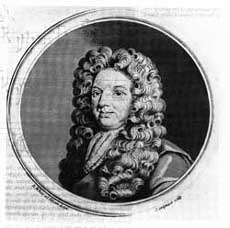John Blow
Composer and organist
1648 - 1708

Children of the Chapel Royal
John Blow enjoyed royal favour through four reigns, starting in 1660 at the Restoration when he became one of the Children of the Chapel Royal at Hampton Court under Captain Henry Cooke.
In 1667 Pepys noted in his diary that:
"This morning come two of Captain Cooke's boys, whose voices are broke, and are gone from the chapel, but have extraordinary skill; and they, and my boy, with his broken voice, did sing three parts; their names were Blaew and Loggings; but notwithstanding their skill, yet to hear them sing with their broken voices, which they could not command to keep in tune, would make a man mad - so bad it was."
His voice had settled by 1685 when he sang as one of the basses at the coronation of James II in Westminster Abbey.
Organist, choirmaster and Chapel Royal Composer
He is still remembered as a composer of church music throughout this time. He was organist of Westminster Abbey from 1669 until 1680 when he surrendered the position to his great pupil Henry Purcell (1661-1698) whom he outlived by 10 years.
In 1673-4 he was sworn in as a Gentleman of the Chapel Royal and became Master of the Children later that year, a post he held for the rest of his life. He was appointed organist of the Chapel Royal in 1676, Choirmaster at St Paul's Cathedral in 1687, Royal instrument tuner in 1695 and in 1699 the official Chapel Royal Composer. Blow was also Composer in Ordinary to James II.
House in Hampton
He lived in Hampton from 1690 to 1708 in a house he built for himself. It was not his only property - he owned at his death eight other houses in the vicinity of Westminster Abbey. The house he built in Hampton, finally demolished in 1799, was on the site of the present-day house known as Beveree in the High Street.
John Blow is buried in Westminster Abbey. His wife died in 1683 in childbirth, and three daughters of his marriage survived him, two sons having died earlier.
Further reading:
Dictionary of National Biography




